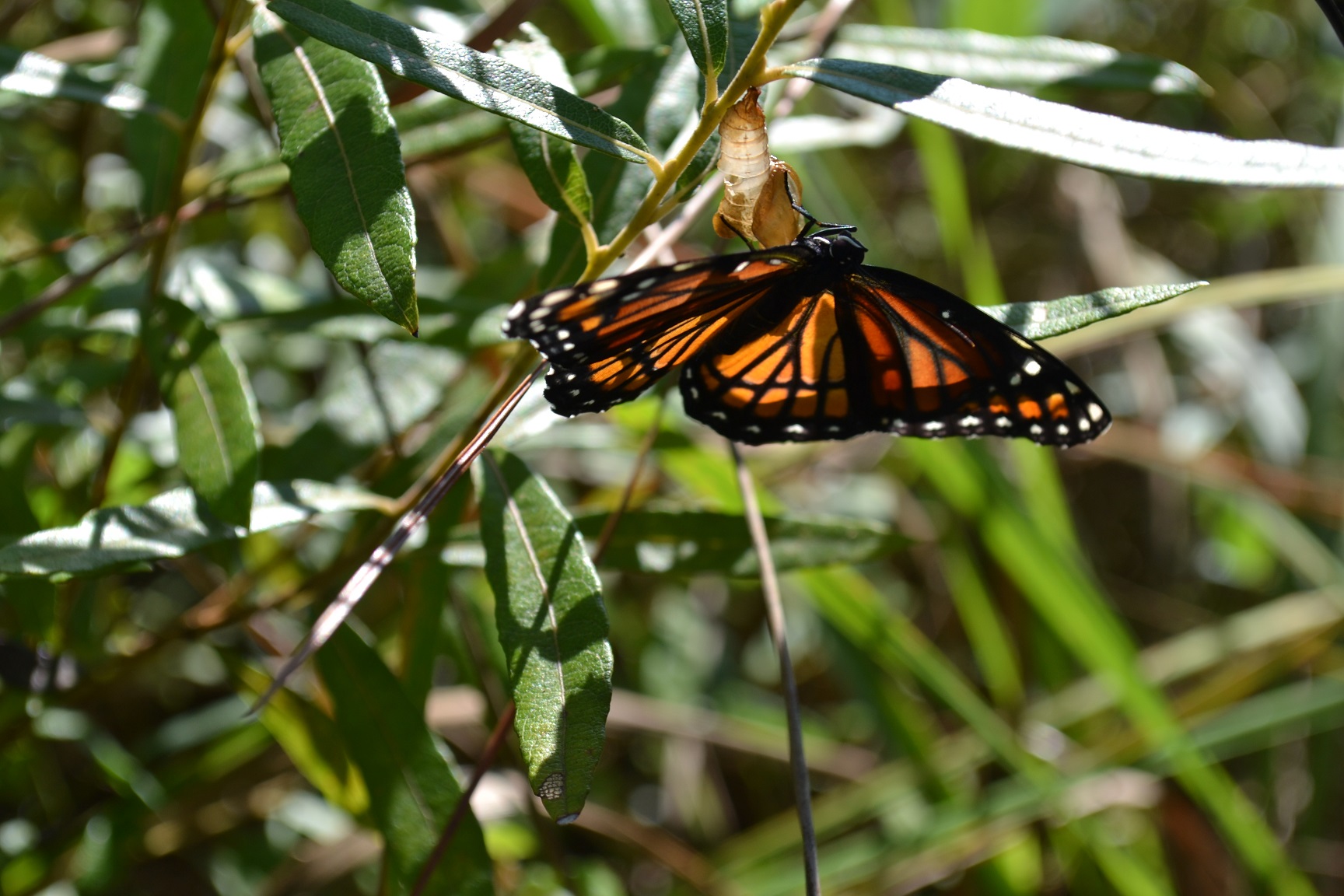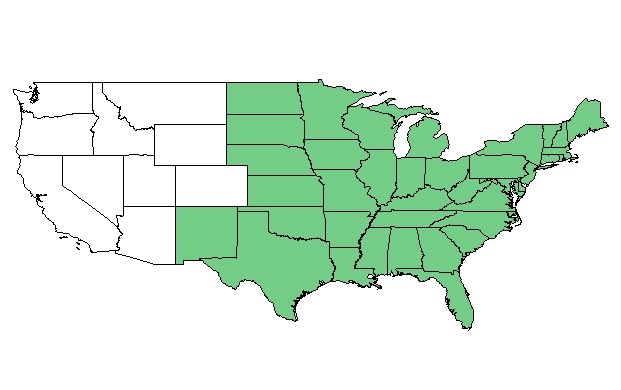Difference between revisions of "Salix humilis"
(→Taxonomic notes) |
HaleighJoM (talk | contribs) (→Ecology) |
||
| (14 intermediate revisions by 6 users not shown) | |||
| Line 1: | Line 1: | ||
| − | Common | + | Common names: Prairie willow, Dwarf willow, Upland willow |
{{italic title}} | {{italic title}} | ||
<!-- Get the taxonomy information from the NRCS Plants database --> | <!-- Get the taxonomy information from the NRCS Plants database --> | ||
| Line 19: | Line 19: | ||
}} | }} | ||
==Taxonomic notes== | ==Taxonomic notes== | ||
| − | Synonyms: ''Salix humilis'' var. ''humilis''; ''S. humilis'' var. ''hyporhysa'' Fernald | + | Synonyms: none |
| + | Varieties: ''Salix humilis'' var. ''humilis''; ''S. humilis'' var. ''hyporhysa'' Fernald | ||
==Description== | ==Description== | ||
<!-- Basic life history facts such as annual/perrenial, monoecious/dioecious, root morphology, seed type, etc. --> | <!-- Basic life history facts such as annual/perrenial, monoecious/dioecious, root morphology, seed type, etc. --> | ||
| − | "Catkins firms, not pendulous. Staminate flower with 2-8 stamens subtended by 1 or 2 glands. Leaves usually more than 3X as long as wide; buds with 1 scale. Capsule basically ovoid." | + | "Catkins firms, not pendulous. Staminate flower with 2-8 stamens subtended by 1 or 2 glands. Leaves usually more than 3X as long as wide; buds with 1 scale. Capsule basically ovoid."<ref name="Radford et al 1964">Radford, Albert E., Harry E. Ahles, and C. Ritchie Bell. Manual of the Vascular Flora of the Carolinas. 1964, 1968. The University of North Carolina Press. 358. Print.</ref> |
| − | "Shrub; branchlets usually cinereous. Leaves glabrous above, glaucous and usually pubescent beneath, coarsely reticulate, oblanceolate, obovate, or elliptic, 1.5-11.5 cm long, 0.6-3 cm wide, acute or obtuse, entire or undulate-crenulate, revolute, base cuneate petioles usually pubescent, 1-9 mm long. Stamens 2, filaments glabrous. Fruiting catkins 1.5-3 cm long, 15-18 mm broad, subsessile; capsules grayish, pubescent, 7-9 mm long, pedicels 1-2 mm long." | + | "Shrub; branchlets usually cinereous. Leaves glabrous above, glaucous and usually pubescent beneath, coarsely reticulate, oblanceolate, obovate, or elliptic, 1.5-11.5 cm long, 0.6-3 cm wide, acute or obtuse, entire or undulate-crenulate, revolute, base cuneate petioles usually pubescent, 1-9 mm long. Stamens 2, filaments glabrous. Fruiting catkins 1.5-3 cm long, 15-18 mm broad, subsessile; capsules grayish, pubescent, 7-9 mm long, pedicels 1-2 mm long."<ref name="Radford et al 1964"/> |
==Distribution== | ==Distribution== | ||
==Ecology== | ==Ecology== | ||
===Habitat=== <!--Natural communities, human disturbed habitats, topography, hydrology, soils, light, fire regime requirements for removal of competition, etc.--> | ===Habitat=== <!--Natural communities, human disturbed habitats, topography, hydrology, soils, light, fire regime requirements for removal of competition, etc.--> | ||
| − | ===Phenology=== <!--Timing off flowering, fruiting, seed dispersal, and environmental triggers. Cite PanFlora website if appropriate: http://www.gilnelson.com/PanFlora/ --> | + | |
| − | ===Seed dispersal=== | + | ''S. humilis'' has been found in pine flatwoods, pond shorelines, and areas with loamy sand.<ref name="FSU"/> It is also found in disturbed areas including burned pine woods, under utility lines, and along hiking trails.<ref name="FSU"> Florida State University Herbarium Database. URL: http://herbarium.bio.fsu.edu. Last accessed: June 2021. Collectors: Loran C. Anderson, R. F. Doren, Robert K. Godfrey, R. Komarek, R. Kral, and William Platt. States and counties: Alabama: Talladega. Florida: Leon and Taylor. Georgia: Grady and Thomas.</ref> |
| − | ===Seed bank and germination=== | + | |
| + | Associated species: ''Pinus palutris, P. elliottii'', and ''Cyrilla parviflora''.<ref name="FSU"/> | ||
| + | <!--===Phenology===--> <!--Timing off flowering, fruiting, seed dispersal, and environmental triggers. Cite PanFlora website if appropriate: http://www.gilnelson.com/PanFlora/ --> | ||
| + | <!--===Seed dispersal===--> | ||
| + | <!--===Seed bank and germination===--> | ||
===Fire ecology=== <!--Fire tolerance, fire dependence, adaptive fire responses--> | ===Fire ecology=== <!--Fire tolerance, fire dependence, adaptive fire responses--> | ||
| − | ===Pollination=== | + | Populations of ''Salix humilis'' have been known to persist through repeated annual burning.<ref>Platt, W.J., R. Carter, G. Nelson, W. Baker, S. Hermann, J. Kane, L. Anderson, M. Smith, K. Robertson. 2021. Unpublished species list of Wade Tract old-growth longleaf pine savanna, Thomasville, Georgia.</ref> |
| − | === | + | |
| − | ===Diseases and parasites=== | + | ===Pollination=== |
| − | ==Conservation and | + | ''Salix humilis'' has been observed to host a variety of bees species. More specifically, the bees observed were members of the Andrenidae family such as ''Andrena arabis, A. bisalicis, A. carlini, A. cressonii, A. fenningeri, A. forbesii, A. frigida, A. hilaris, A. imitatrix, A. mandibularis, A. miserabilis, A. nasonii, A. nigrihirta, A. rugosa, A. sigmundi, A. tridens'' and ''A. vicina'', members of the Apidae family such as ''Apis mellifera, Nomada bella, N. luteoloides'' and ''N. xanthura'', ''Cavariella sp.'' (family Aphididae), members of the Halictidae family such as ''Augochlora pura, A. aurata, Halictus ligatus, Lasioglossum acuminatum, L. bruneri, L. coeruleum, L. coriaceum, L. cressonii, L. imitatum, L. leucocomum, L. paradmirandum, L. versatum, Sphecodes aroniae'' and ''S. minor'', and members of the Megachilidae family ''Osmia atriventris'' and ''O. lignaria''.<ref>Discoverlife.org [https://www.discoverlife.org/20/q?search=Bidens+albaDiscoverlife.org|Discoverlife.org]</ref> |
| − | == | + | <!--===Herbivory and toxicology===<!--Common herbivores, granivory, insect hosting, poisonous chemicals, allelopathy, etc--> |
| + | <!--===Diseases and parasites===--> | ||
| + | |||
| + | ==Conservation, cultivation, and restoration== | ||
| + | |||
| + | ==Cultural use== | ||
| + | |||
==Photo Gallery== | ==Photo Gallery== | ||
<gallery widths=180px> | <gallery widths=180px> | ||
</gallery> | </gallery> | ||
==References and notes== | ==References and notes== | ||
| − | |||
Latest revision as of 15:51, 15 July 2022
Common names: Prairie willow, Dwarf willow, Upland willow
| Salix humilis | |
|---|---|

| |
| Salix humilis with Viceroy butterfly just enclosed from chrysalis. Wade Tract, GA. Photo by Kevin Robertson | |
| Scientific classification | |
| Kingdom: | Plantae |
| Division: | Magnoliophyta - Flowering plants |
| Class: | Magnoliopsida - Dicotyledons |
| Order: | Salicales |
| Family: | Salicaceae |
| Genus: | Salix |
| Species: | S. humilis |
| Binomial name | |
| Salix humilis Marshall | |

| |
| Natural range of Salix humilis from the Ladybird Johnson Wildflower Database. | |
Contents
Taxonomic notes
Synonyms: none Varieties: Salix humilis var. humilis; S. humilis var. hyporhysa Fernald
Description
"Catkins firms, not pendulous. Staminate flower with 2-8 stamens subtended by 1 or 2 glands. Leaves usually more than 3X as long as wide; buds with 1 scale. Capsule basically ovoid."[1]
"Shrub; branchlets usually cinereous. Leaves glabrous above, glaucous and usually pubescent beneath, coarsely reticulate, oblanceolate, obovate, or elliptic, 1.5-11.5 cm long, 0.6-3 cm wide, acute or obtuse, entire or undulate-crenulate, revolute, base cuneate petioles usually pubescent, 1-9 mm long. Stamens 2, filaments glabrous. Fruiting catkins 1.5-3 cm long, 15-18 mm broad, subsessile; capsules grayish, pubescent, 7-9 mm long, pedicels 1-2 mm long."[1]
Distribution
Ecology
Habitat
S. humilis has been found in pine flatwoods, pond shorelines, and areas with loamy sand.[2] It is also found in disturbed areas including burned pine woods, under utility lines, and along hiking trails.[2]
Associated species: Pinus palutris, P. elliottii, and Cyrilla parviflora.[2]
Fire ecology
Populations of Salix humilis have been known to persist through repeated annual burning.[3]
Pollination
Salix humilis has been observed to host a variety of bees species. More specifically, the bees observed were members of the Andrenidae family such as Andrena arabis, A. bisalicis, A. carlini, A. cressonii, A. fenningeri, A. forbesii, A. frigida, A. hilaris, A. imitatrix, A. mandibularis, A. miserabilis, A. nasonii, A. nigrihirta, A. rugosa, A. sigmundi, A. tridens and A. vicina, members of the Apidae family such as Apis mellifera, Nomada bella, N. luteoloides and N. xanthura, Cavariella sp. (family Aphididae), members of the Halictidae family such as Augochlora pura, A. aurata, Halictus ligatus, Lasioglossum acuminatum, L. bruneri, L. coeruleum, L. coriaceum, L. cressonii, L. imitatum, L. leucocomum, L. paradmirandum, L. versatum, Sphecodes aroniae and S. minor, and members of the Megachilidae family Osmia atriventris and O. lignaria.[4]
Conservation, cultivation, and restoration
Cultural use
Photo Gallery
References and notes
- ↑ 1.0 1.1 Radford, Albert E., Harry E. Ahles, and C. Ritchie Bell. Manual of the Vascular Flora of the Carolinas. 1964, 1968. The University of North Carolina Press. 358. Print.
- ↑ 2.0 2.1 2.2 Florida State University Herbarium Database. URL: http://herbarium.bio.fsu.edu. Last accessed: June 2021. Collectors: Loran C. Anderson, R. F. Doren, Robert K. Godfrey, R. Komarek, R. Kral, and William Platt. States and counties: Alabama: Talladega. Florida: Leon and Taylor. Georgia: Grady and Thomas.
- ↑ Platt, W.J., R. Carter, G. Nelson, W. Baker, S. Hermann, J. Kane, L. Anderson, M. Smith, K. Robertson. 2021. Unpublished species list of Wade Tract old-growth longleaf pine savanna, Thomasville, Georgia.
- ↑ Discoverlife.org [1]